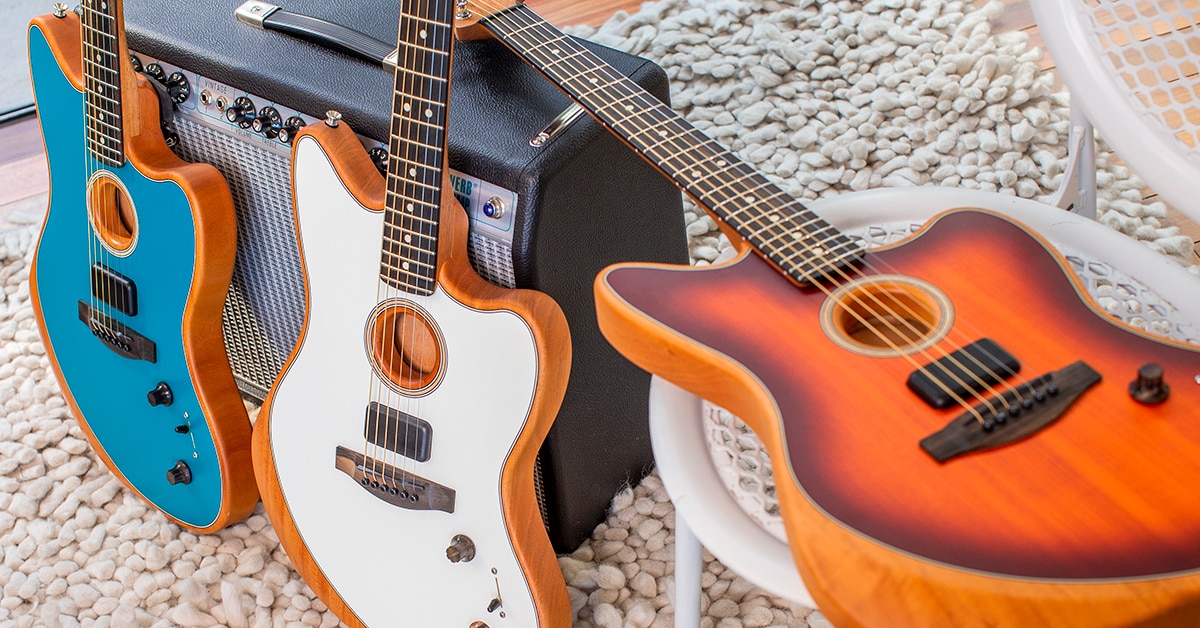The Fender Acoustasonic Jazzmaster combines the iconic Jazzmaster body style with hybrid electroacoustic technology to create a shape-shifting instrument that inspires the same sonic curiosity as the original. Joining the Telecaster and Stratocaster in the Acoustasonic lineup, the Jazzmaster's larger offset body yields a resonance that makes the Fender and Fishman-designed sound engine take on a new character—while introducing fresh voices like Mahogany Jumbo and Lo-Fi Piezo. With a Tim Shaw-designed humbucker for big electric guitar tones and a variety of acoustic settings, players will have a spectrum of possibilities at their fingertips.
We spoke with Billy Martinez, VP category manager (Acoustic and Squier Divisions) at Fender, about how the Acoustasonic Jazzmaster follows in the experimental footsteps of its namesake while adventuring into new tonal territory.
Often used to push the boundaries of sonic exploration, the Jazzmaster is the guitar of choice of many of the iconic, enduring musicians of the indie music scene, from Kevin Shields to Thurston Moore to J Mascis. How do you pay tribute to that history, manifesting that ethos of experimentation into this unique model?
Billy Martinez: The Jazzmaster has always made a name for itself in many genres, from Elvis Costello to Sonic Youth, as well as the artists you mentioned. Taking that knowledge and embracing it, the Acoustasonic Jazzmaster lends itself to explore sonic opportunities. We really wanted guitar players to have an array of acoustic and electric tones to create their own unique sound, just as artists have done with the Jazzmaster in the past.
What does the Jazzmaster body give you from a design perspective?
The larger body allowed us to offer more unique voices and give the Jazzmaster its own identity within the Acoustasonic platform. Right away, players will notice the acoustic sound it produces, without being plugged in, has a bolder sound. Layer in the electronics and it's easy to see that the Jazzmaster body took the voicings to a whole new level. We're excited to see how guitar players will use it to create their own sound.
How close are the acoustic voices in this model as compared to the Telecaster or Stratocaster models?
There are similar voices in this guitar, and because the Jazzmaster has a larger body shape, they will sound different. That's the great thing about these instruments. The guitars in their analog forms really affect the tonal characteristics, and each [model] has its own identity.
How would you describe the lo-fi voicings? Was there a starting point for inspiration?
In Position 2A, we were able to use the larger body shape to stand along with the under-saddle piezo pickup, so the guitar is acting as a traditional acoustic guitar with its own tonal capabilities. Roll the blend knob clockwise, and we created a sound that is raw and in your face by adding some grit and gain to the piezo pickup, which I think sounds amazing.
How does the pickup system work?
In Position 1, we utilize the Acoustasonic Shawbucker pickup for the electric tones. In Positions 2, 4 and 5, we use the under-saddle piezo pickup to capture the acoustic tones. Position 3A uses the same under-saddle pickup, but then blends in the body sensing pickup, using both pickups together to create a very bold tone.

Were there any unexpected learnings when putting together this model?
One of the unique things we discovered, as I mentioned above, is the ability to let the guitar and piezo work in a more traditional fashion. The body shape allowed us to create a new acoustic body shape, and that was really exciting in a guitar with these types of design elements.
Given the unique voicing options and combinations available to players, is there a specific rig that you'd recommend?
First and foremost, I would play it direct or through a PA speaker, so the player can hear all of the different tone options this guitar has in its most pure form. Another great option is to use an A-B-Y box to use an acoustic amp for the acoustic voices and then easily switch to an electric amp for the electric tones. But really, the options are open to each player's interpretation of what "their sound" is, and how they use it.
Do you have a favorite voice or voicing combination?
My personal favorites are 2b and 3b. I love the lo-fi crunch in 2b because of how unique it is. Additionally, I've always gravitated towards the acoustic sounds with the body sensor fully engaged in all three models.








